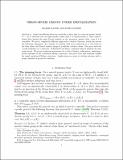| dc.contributor.author | Maulik, Davesh | |
| dc.contributor.author | Poonen, Bjorn | |
| dc.date.accessioned | 2013-09-13T12:41:58Z | |
| dc.date.available | 2013-09-13T12:41:58Z | |
| dc.date.issued | 2012-08 | |
| dc.date.submitted | 2011-11 | |
| dc.identifier.issn | 0012-7094 | |
| dc.identifier.uri | http://hdl.handle.net/1721.1/80706 | |
| dc.description.abstract | Andre used Hodge-theoretic methods to show that in a smooth proper family X → B of varieties over an algebraically closed field k of characteristic zero, there exists a closed fiber having the same Picard number as the geometric generic fiber, even if k is countable. We give a completely different approach to André’s theorem, which also proves the following refinement: in a family of varieties with good reduction at p, the locus on the base where the Picard number jumps is p-adically nowhere dense. Our proof uses the “p-adic Lefschetz (1,1)-theorem” of Berthelot and Ogus, combined with an analysis of p-adic power series. We prove analogous statements for cycles of higher codimension, assuming a p-adic analogue of the variational Hodge conjecture, and prove that this analogue implies the usual variational Hodge conjecture. Applications are given to abelian schemes and to proper families of projective varieties. | en_US |
| dc.description.sponsorship | National Science Foundation (U.S.) (Grant DMS-0841321) | en_US |
| dc.description.sponsorship | National Science Foundation (U.S.) (Grant DMS-1069236) | en_US |
| dc.language.iso | en_US | |
| dc.publisher | Duke University Press | en_US |
| dc.relation.isversionof | http://dx.doi.org/10.1215/00127094-1699490 | en_US |
| dc.rights | Creative Commons Attribution-Noncommercial-Share Alike 3.0 | en_US |
| dc.rights.uri | http://creativecommons.org/licenses/by-nc-sa/3.0/ | en_US |
| dc.source | MIT web domain | en_US |
| dc.title | Neron–Severi groups under specialization | en_US |
| dc.type | Article | en_US |
| dc.identifier.citation | Maulik, Davesh, and Bjorn Poonen. “Néron–Severi groups under specialization.” Duke Mathematical Journal 161, no. 11 (August 2012): 2167-2206. | en_US |
| dc.contributor.department | Massachusetts Institute of Technology. Department of Mathematics | en_US |
| dc.contributor.mitauthor | Poonen, Bjorn | en_US |
| dc.relation.journal | Duke Mathematical Journal | en_US |
| dc.eprint.version | Author's final manuscript | en_US |
| dc.type.uri | http://purl.org/eprint/type/JournalArticle | en_US |
| eprint.status | http://purl.org/eprint/status/PeerReviewed | en_US |
| dspace.orderedauthors | Maulik, Davesh; Poonen, Bjorn | en_US |
| dc.identifier.orcid | https://orcid.org/0000-0002-8593-2792 | |
| mit.license | OPEN_ACCESS_POLICY | en_US |
| mit.metadata.status | Complete | |
